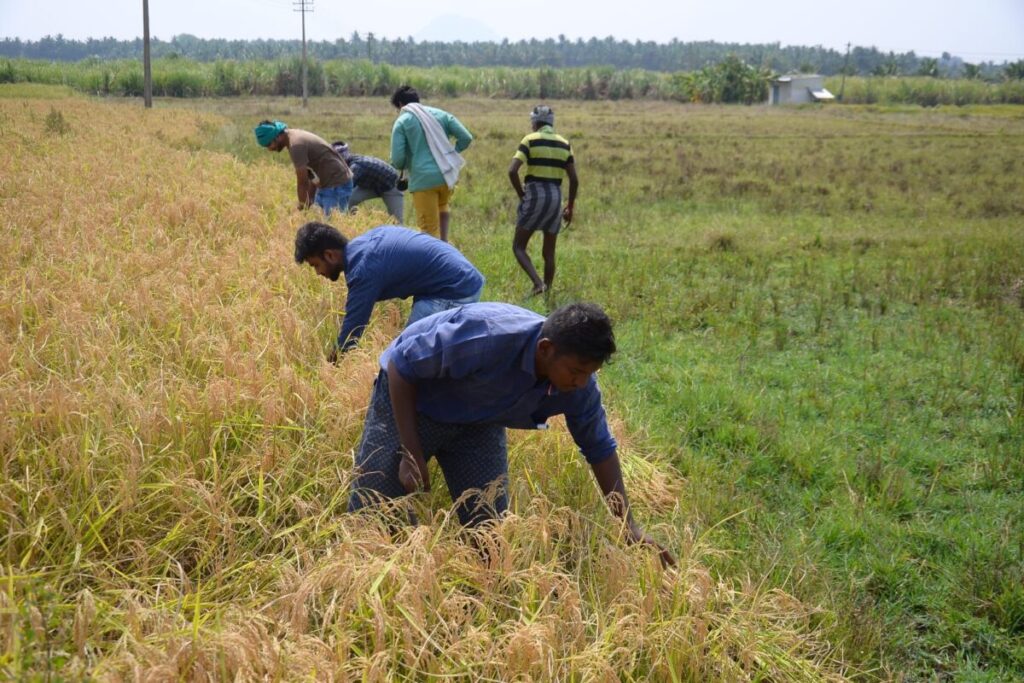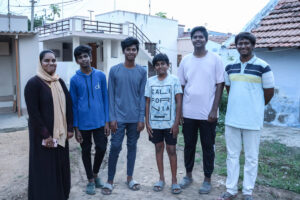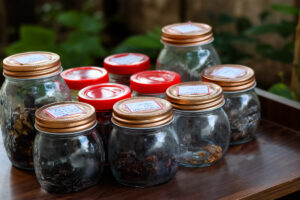Climate Change Response: A Village Nurtures Traditional Food Systems
Jan 17, 2024 | Pratirodh Bureau
Members of Eegai Kuzhu, an informal organisation of village youth trying to revive traditional food and seeds, harvest indigenous paddy at Tamil Nadu's Kuralkuttai (Photo by Balasubramaniam N./Mongabay)
- The once-predominant reliance on traditional crops such as white corn and millets in the Tamil Nadu village of Kuralkuttai underwent a significant shift during the Green Revolution, altering the village’s agricultural landscape.
- A village youth organisation, Eegai Kuzhu, works with the community to revive disappearing crops, document ancestral food habits and promote sustainable farming practices.
- Eegai Kuzhu, along with the Biodiversity Management Committee, document local biodiversity, conduct tree censuses and have established a seed bank, contributing to climate-resilient farming practices in Kuralkuttai.
“In our childhood, the resonating sound of ulakkai (a stone pestle) grinding cholam (white corn) was our daily wake-up call. Our mother would sift it to make chola kali (corn porridge), a ritual we followed for all our meals,” recalls 76-year-old Subash Krishnasamy from Kuralkuttai, a small village in Tamil Nadu with a population a little over 4000, mostly comprising farmers and weavers.
Krishnasamy reflects on the days when their fields and kitchen gardens flourished with cholam and samai (little millet), along with crops like ragi (finger millet), thinai (foxtail millet), thatta payiru (cow peas), paasi payiru (moong dal) and tomatoes. “There was hardly any need for us to go to the market. Then the poor man’s staple millet is the rich man’s organic meal today,” he adds, reminiscing about the rich agricultural diversity that once sustained them.
The winds of change, however, swept through the region with the advent of the Green Revolution in the 1960s, steering the agricultural landscape toward cash crops and irrigation-dependent varieties, notably rice. Krishnaswamy vividly describes the evolution, “We used to grow two types of tomatoes — a smaller variety, the size of a gooseberry and a larger one, so big it could be split to two medium ones.” These stories capture the essence of a bygone era.
An Organisation Revives Disappearing Crops And Food Habits
Mukesh Gauthaman, a 25-year-old chemical engineer, is at the forefront of documenting and reviving the traditional food and lifestyle of Kuralkuttai. Gauthaman, who lost his grandparents to cancer, embarked on a journey to explore the village’s food and lifestyle choices. His quest led to the formation of Eegai Kuzhu (Eegai is the Tamil word for giving and Kuzhu translates to group), an informal organisation of village youth dedicated to preserving and reviving disappearing crops and vegetables. From learning how corn seeds were preserved in underground pits or dung balls to recognising local edible weeds, the members of Eegai Kuzhu comprising chemical engineers, IT professionals, school students, etc. have documented the lost food and lifestyle of their village.
Eegai Kuzhu shares Gauthaman’s belief in nature-integrated farming. “We decided to take on the problem of moths, considered pests, as most of our village crops were affected by it. Soon enough, we understood how they evolved with the plants. In fact, recent studies also show that moths pollinate more than bees at night,” he said. Unable to convince the farmers on the importance of chemical-free farming and maintaining soil health and integrity, he turned to the children of the village. “We taught them to learn by observing moths and insects in our workshops,” he said. Frequent nature walks and discussion helped the children and interested adults in understanding the symbiotic relationship among various organisms in the ecosystem.
Youth Come Forward To Be The Voice Of The Movement
The younger members of Eegai Kuzhu have embraced the cause with enthusiasm. Twelve-year-old Vetrivel actively shares insights about local biodiversity on the organisation’s YouTube channel, stating, “Did you know that dung beetles play an important role in preserving forests?” He shares details about his observations of nature, like the social spiders’ hunting pattern and how a bird’s beak acts as a spoon to scoop its prey. This youth engagement is not just limited to videos; it extends to social media, where the group documents and promotes the lost food habits of their ancestors.
Raziya Begum, an Eegai Kuzhu member and the newly elected head of the village’s Biodiversity Management Committee (BMC), sheds light on their multifaceted initiatives. “Apart from the food history, the team has been collating information on local biodiversity,” she explains. This includes a tree census, contributions to platforms like SeasonWatch and eBird, and the documentation of traditional practices shared by the village elders.

“A farmer told us about how the British bred cochineal insects (maavu poochi in local parlance) on cactus plants in India for carmine, a natural red dye. We can still see these insects on the neighbourhood hillocks. Another farmer told me about the sweet gum oozing out of the Arappu tree (Albizia amara), which makes for an excellent snack. From herbal concoctions for toothaches to traditional wood used for knives, we have documented many stories of our farmers and elders,” Gauthaman said.
The members of Eegai Kuzhu believe that the BMC can serve as a catalyst for other villages, inspiring hyper-local conservation efforts and bio-resource-based green industries. Gauthaman envisions the BMC funding the documentation of local bioresources at a grassroots level, creating a library or bioresource centre to ensure their sustainable usage.
Nature Walks And Seed Banks Carry The Essence Of Conservation
Conservationist Karthik from the Tamil Nadu Organic Farming Cooperative emphasised on the close relationship between food systems and climate change. Initiatives like Eegai Kuzhu, which localise food systems, are seen as crucial in addressing climate crises.
They also conduct nature walks in Kuralkuttai. Having completed seven years, these nature walks are now popular even outside Kuralkuttai. IT engineer Vishnuvardhan, who participated in one such nature walk to Jallipatu Karadu (or hillock), found it fascinating. “I was amazed to find how the antlion captures its prey through a funnel-like structure,” he said, adding that he wished more people benefited from it. Begum revealed the BMC’s plan to conduct biodiversity awareness programmes in local schools.

Studies have shown that seed diversity and community seed banks can help build resilience among farmers against climate change. Eegai Kuzhu has built a seed bank at Kuralkuttai by collecting climate-resilient native seeds from local farmers. The team has managed to revive traditional paddy varieties such as Sirumani Samba, Thanga Samba, Karthigai Samba and Manalvari, that disappeared from the region almost 70 years ago. “We have distributed certain local seeds of Udumalai Samba, air potato, purple margin field bean and more to over 40 people,” said Begum. She said that people in Kuralkuttai have begun to understand the importance of local herbs and plants after their intervention and started cooking with local vegetables and greens that were considered weeds till recently.
Eegai Kuzhu also runs a startup called Eegai Foods that connects organic farmers with approximately a hundred customers in the region, promoting the consumption of local produce. While there are aspirations for expansion, the current focus remains on reintegrating local crops into kitchens, marking a step towards sustainable and climate-resilient food practices. “Once we get these greens, crops and vegetables back into the kitchen, our job is done,” Begum said.
(Published under Creative Commons from Mongabay-India. Read the original article here)
